Key takeaways:
- Typeface selection is integral to conveying a brand’s personality and impacts readability and emotional resonance.
- Context, target audience, and personal affinity significantly influence typeface choices in publishing and design.
- Accessibility and legibility are crucial considerations; a well-chosen typeface enhances reader engagement and inclusivity.
- Final decisions in typeface selection often rely on instinct and practical outcomes, balancing aesthetics with functionality.
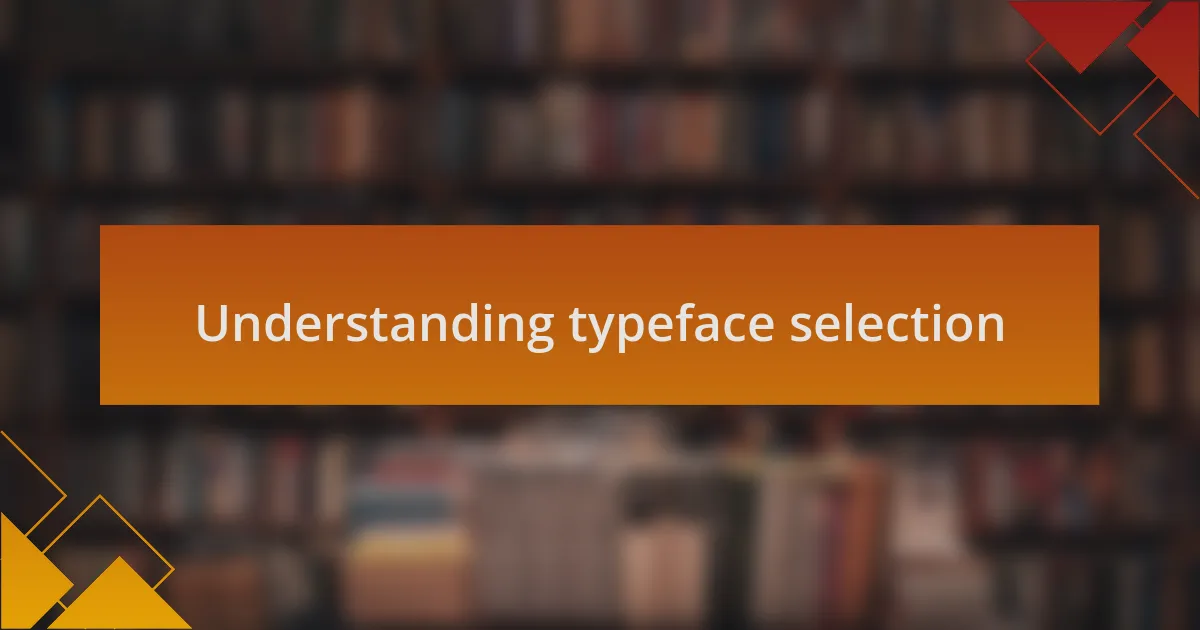
Understanding typeface selection
Typeface selection is not just about picking what looks good; it’s a crucial aspect that conveys a brand’s personality. I remember spending hours poring over different fonts when designing my own first publication. The weight and style of each typeface evoke emotions—they can feel welcoming or distant, modern or traditional. Have you ever noticed how a simple change in font can shift the entire tone of a message?
Understanding the nuances of typefaces can feel overwhelming at times. For example, serif fonts often convey formality and trustworthiness—think of classic novels or academic papers. However, when I chose a sans-serif typeface for my website, I aimed for a clean, contemporary feel. It was essential for me to align that choice with my audience’s expectations while ensuring readability and accessibility.
As I navigated my options, I also considered how different typefaces might read on various devices. I once had a manuscript with a beautiful script font; it looked stunning in print, but on screen, it was nearly illegible. This experience taught me that typeface selection is not only about aesthetics but also functionality. What’s the point of a gorgeous font if it hinders communication?

Importance of typeface in publishing
Typeface plays a pivotal role in publishing, acting as the invisible thread that ties together visual communication and reader perception. When I published my first poetry collection, I chose a delicate serif typeface that mirrored the lyrical quality of my verses. The feedback was immediate; readers noted how the choice enhanced their emotional connection to the words. Isn’t it fascinating how a font can elevate the reader’s experience beyond the text itself?
Moreover, it’s essential to recognize that typeface creates an atmosphere, guiding the reader’s mood and expectations. During my time working on a self-help book, I initially opted for a bold typeface, believing it would convey strength and clarity. However, after sharing it with a few trusted colleagues, I realized that a softer, rounded font would make the content feel more approachable. Have you ever picked up a book and felt instantly comfortable or anxious purely based on the font choice?
Additionally, accessibility cannot be overlooked. After struggling with a poorly chosen typeface for a digital magazine, which frustrated both me and the readers, I learned how vital legibility is. I remember switching to a more accessible font for my next issue, and the difference was remarkable—readers actually remarked on how much easier it was to engage with the content. Shouldn’t every publisher strive for clarity to ensure everyone feels included in the conversation?
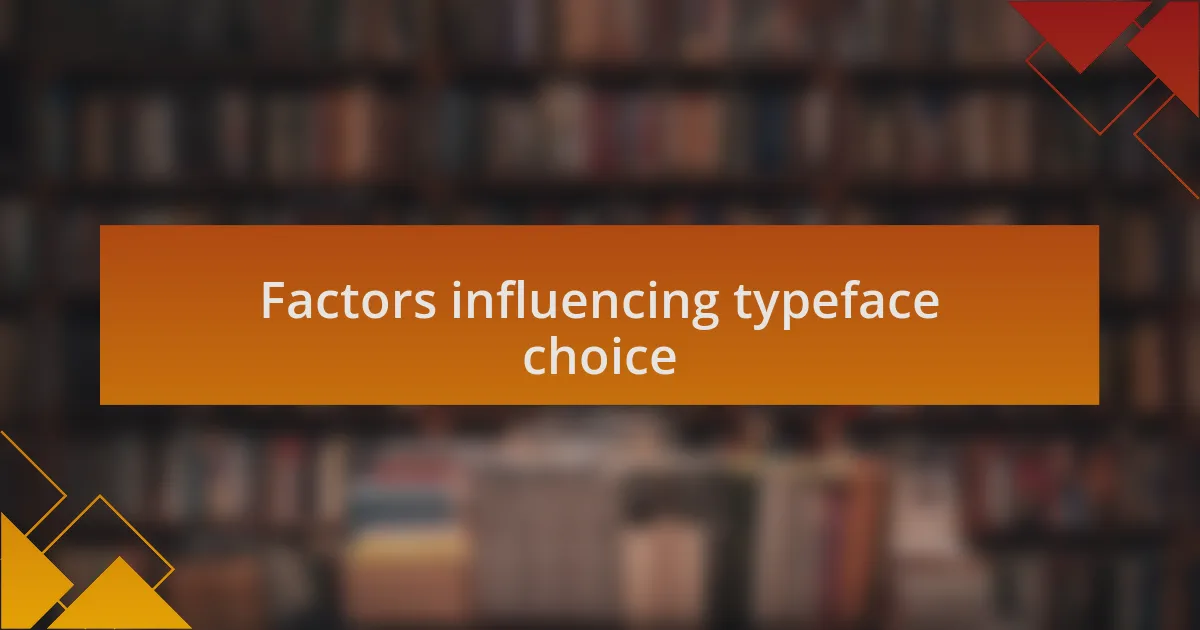
Factors influencing typeface choice
When considering typeface choice, context is crucial. For instance, while designing a children’s book, I discovered that playful fonts not only captured the spirit of the stories but also invited young readers to engage with the text. Can you imagine the joy of a child picking up a book with a font that seems to jump off the page?
Another significant factor is target audience. I recall when I was developing marketing materials for a niche academic journal. Initially, I gravitated towards a sleek, modern typeface, thinking it would resonate with the younger scholars. Yet, feedback revealed that traditional serif fonts fostered a sense of credibility and trust, aligning better with the seasoned academics we aimed to reach. Isn’t it remarkable how understanding your audience can transform a design choice?
Finally, personal affinity plays a role too. I once selected a typeface for a memoir that reflected personal nostalgia, evoking the era it was written in. Readers later told me that the font brought back memories tied to the stories, creating a shared experience. Can you see how typeface can transcend mere aesthetics and forge connections between the author and the reader?

Analyzing different typeface categories
When analyzing different typeface categories, I often find myself drawn to the distinctions between serif and sans-serif fonts. For example, I once designed a literary magazine and opted for a classic serif font for the title, believing it conveyed that timeless elegance anchoring the content. It was fascinating to see how readers perceived a sense of reliability and tradition, creating an immediate connection to the literary world.
On the flip side, I experimented with sans-serif fonts for a modern poetry collection. Their clean lines and contemporary feel allowed the words to breathe and resonate with younger audiences. Isn’t it intriguing how a seemingly simple choice can alter the emotional impact of the text? I noticed that readers appreciated the modern touch, which made the poems feel more accessible and relatable.
Additionally, I explored display typefaces for a vibrant art book. These fonts often carry a distinct personality, and my initial choice was bold and playful, capturing the spirit of the artwork. However, after testing it with a focus group, I learned that a slightly more subdued display typeface engaged the audience better—maintaining the artistic flair while not overpowering the images. Have you ever changed your mind about a design choice after seeing it in action? It’s a reminder that typefaces are not just about aesthetics; they influence the entire reading experience.
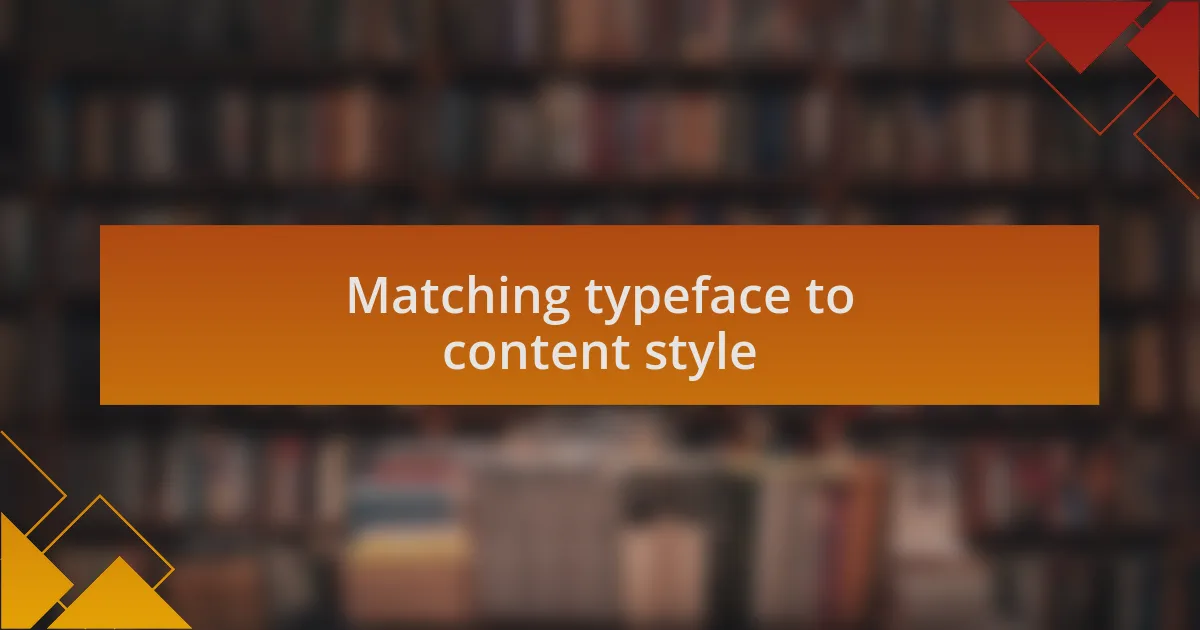
Matching typeface to content style
Choosing a typeface to match the content style is an intricate dance between visual appeal and emotional resonance. For instance, while working on a recent self-help publication, I decided to use a rounded sans-serif font to evoke warmth and approachability. I noticed that this choice fostered a sense of trust, drawing readers in as if they were having a conversation over coffee rather than reading a manual. Isn’t it interesting how a typeface can shape our emotional response before we even delve into the text?
In another project, I crafted a scholarly journal and instinctively selected a traditional serif font. The decision was rooted in my belief that it would project authority and gravitas. However, I found that the delicate balance of readability and sophistication was paramount. I recall the discussions I had with my peers about the influence of typography on scholarly communication. We all agreed that the right typeface not only delivers information but also enhances the intellectual engagement of the reader.
Moreover, when designing a travel blog, I wanted to evoke wanderlust right from the homepage. I opted for an adventurous script font, thinking it would blend perfectly with the themes of exploration and spontaneity. To my surprise, while it captured attention, it lacked legibility in body text. This experience made me realize that even creative, expressive fonts must prioritize user experience. Have you ever hesitated between an artistic choice and practical needs? It’s these evolving preferences that often lead to more nuanced design outcomes.
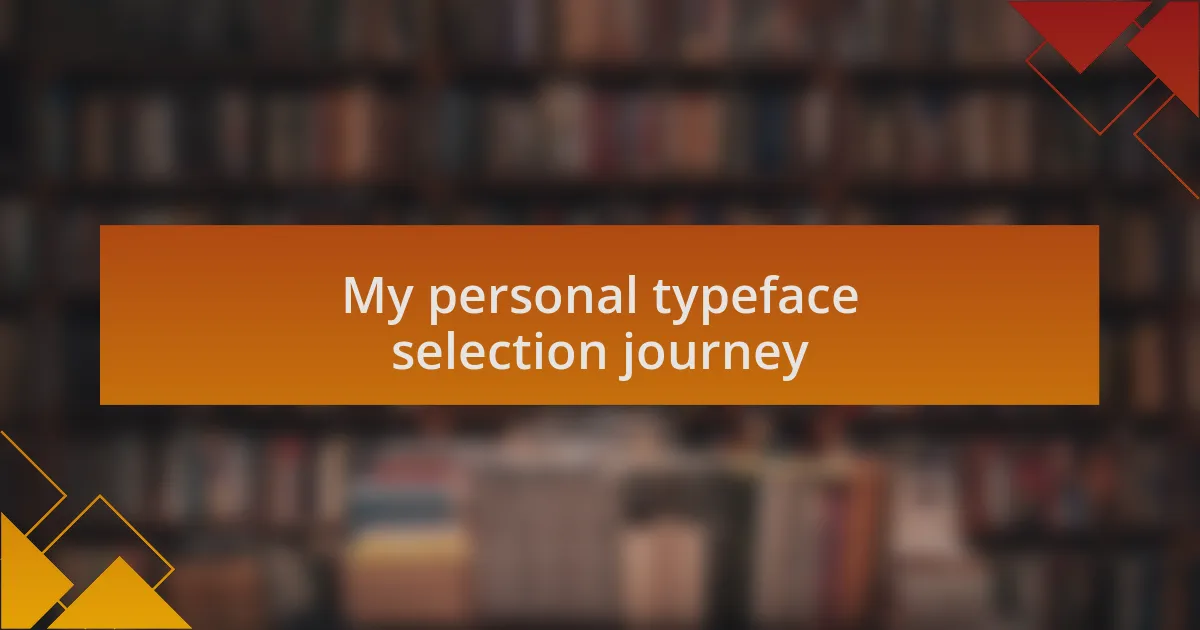
My personal typeface selection journey
Selecting the perfect typeface has been quite the adventure for me. I remember the first time I worked on a poetry book; I wanted to reflect the delicate nuances of each poem through my typeface choice. After countless hours of experimenting, I landed on a light, italic serif. It not only complemented the dreamy quality of the verses but also managed to evoke a sense of intimacy, almost as if the words were whispering secrets to the reader.
On another occasion, while creating a children’s book, I faced a dilemma. I was initially drawn to a whimsical typeface that captured the playful spirit of the stories. However, after sharing a draft with some young readers, their feedback made me rethink my choice. I realized that a balance between fun and readability was crucial. Isn’t it fascinating how the audience’s perspective can shape your creative decisions?
Finally, when I was designing a website for an independent author, I found myself caught between modern minimalism and vintage charm. I ultimately chose a modern sans-serif font but paired it with subtle textures and colors that paid tribute to the author’s literary influences. This combination sparked a new disquieting question in my mind: How can typography be both a nod to the past and a beacon of the future? This journey through typeface selection continually deepens my appreciation for how much personality a simple font can express.
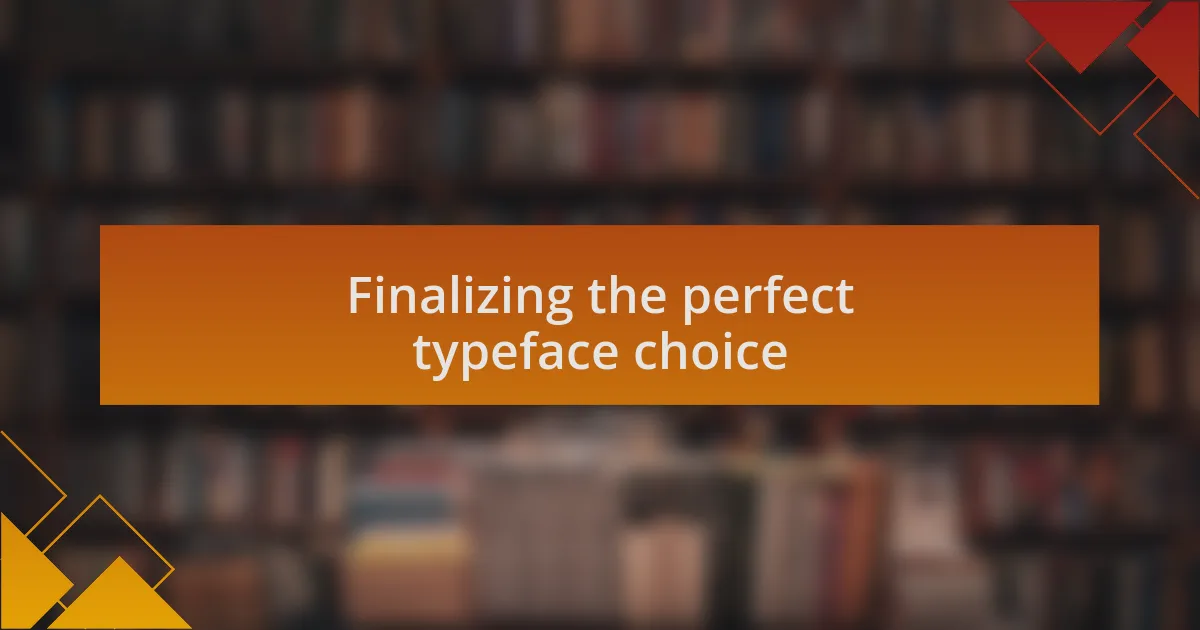
Finalizing the perfect typeface choice
Finalizing the perfect typeface often feels like putting the last piece in a puzzle. While I was wrapping up a zine focused on urban culture, I needed a typeface that echoed the vibrancy of street art. After some trial and error, I settled on a bold, dynamic sans-serif that brought the energy of the city to life, instantly transforming the reader’s experience. Isn’t it incredible how the right typeface can evoke a sense of place?
As I was finalizing my choice for a nonfiction project about sustainable living, the stakes felt particularly high. I wanted to convey clarity and approachability, but also a sense of urgency. I chose a clean serif typeface with ample spacing, which not only enhanced legibility but also made the content feel inviting—very much aligned with the message of inclusivity. It made me wonder: How much do our typefaces influence the way we perceive important social issues?
The final decision often comes down to gut feeling, and I can’t stress enough how important that instinct is. While selecting the font for my travel essays, I experimented with a few options that appeared perfect on screen, but once I printed them out, they fell flat. The realization that a typeface might look stunning digitally but fail to resonate on paper was a game changer for me. Have you ever felt that disconnect when transitioning from the screen to the page?